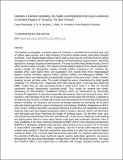| dc.description.abstract | The Dodoma municipality, a semiarid region of Tanzania, is characterized by limited rains, lack of surface water sources, and a high frequency of extreme climate events, particularly droughts and floods. These disadvantaged settings make it vital to study long-term climate trends for signals and patterns of shifting climate regimes for integrity of local livelihood support systems, especially agriculture, recharge, and pasture developments. The area has fairly long climate records, some of which extend to about 100 years. This chapter presents detailed analysis of six climate parameters, namely, rainfall (R), atmospheric relative humidity (ARH), temperature (T), sunshine (S), radiation (RD), wind speed (WS), and evaporation (ET) records from three meteorological stations, namely, Hombolo Agrovet (HMS), Dodoma (DMS), and Makutupora (MMS). The parameters above were statistically and graphically analyzed in four time scales, namely, monthly, seasonal, annual, and time series. The results showed the area is characterized by slight spatial variability in R intensity and T magnitudes with HMS having higher T and rains than DMS and MMS. Further there are clear decreasing trends in ARH and R, while T, S, WS, ET, and RD parameters showed characteristic increasing trends. Thus, except for extreme rain events, particularly El Niño-Southern Oscillations (ENSO), which are characterized by abnormally increased R magnitudes, R intensity has generally decreased in which over the past 91 years, there has been a net R decrease of 54 mm out of annual rains of only about 550 mm/year. Compared to annual time step, however, monthly step reveals more silent features like shortening of the growing seasons. Similarly, the frequency and severity of drought episodes are increasing, all of which adversely impact agriculture, pasture development, and recharge. Similarly, disappearance of R in some months, shifting seasonality, and general declining R intensities and magnitudes are clearly observed. May rains have largely disappeared, while in January, February, March, and April rains have decreased and hence shortening the length of growing season. On the other hand, clear warming trends and declining ARH were also observed. Yet the area is marked by cyclic wetting and drying events where in recent years, drying cycles have been prolonged. However, there is more variability in the mean minimum temperature (MMT) than in mean maximum temperatures (MMMT) in all stations. Between 1961 and 2012, there has been a net 1.13 and 0.778 °C increases in annual MMT and MMMT in DMS, respectively. Like for R trends, silent features are more evident under monthly T data than annual time steps where it is clear that June had the highest increase in MMT (1.54 °C), while April had the least (only 0.662 °C). However, both trends have the potential of affecting major livelihood support systems particularly agriculture and pasture development, but also local groundwater recharge that is vital for the local economy. The study area therefore offers a rare opportunity to understand and manage changing climate regimes including on extent of dry spells and longevity of growing seasons. The changing climate trends consequently call for significant adaptation and mitigation strategies so that local activities adjust to the current climate regimes particularly on onset and end of rainfall seasons and recharge fluxes. | en_US |

